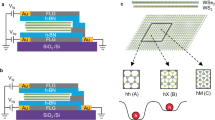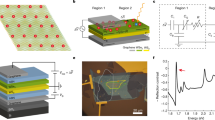Abstract
Moiré superlattices enable the generation of new quantum phenomena in two-dimensional heterostructures, in which the interactions between the atomically thin layers qualitatively change the electronic band structure of the superlattice. For example, mini-Dirac points, tunable Mott insulator states and the Hofstadter butterfly pattern can emerge in different types of graphene/boron nitride moiré superlattices, whereas correlated insulating states and superconductivity have been reported in twisted bilayer graphene moiré superlattices1,2,3,4,5,6,7,8,9,10,11,12. In addition to their pronounced effects on single-particle states, moiré superlattices have recently been predicted to host excited states such as moiré exciton bands13,14,15. Here we report the observation of moiré superlattice exciton states in tungsten diselenide/tungsten disulfide (WSe2/WS2) heterostructures in which the layers are closely aligned. These moiré exciton states manifest as multiple emergent peaks around the original WSe2 A exciton resonance in the absorption spectra, and they exhibit gate dependences that are distinct from that of the A exciton in WSe2 monolayers and in WSe2/WS2 heterostructures with large twist angles. These phenomena can be described by a theoretical model in which the periodic moiré potential is much stronger than the exciton kinetic energy and generates multiple flat exciton minibands. The moiré exciton bands provide an attractive platform from which to explore and control excited states of matter, such as topological excitons and a correlated exciton Hubbard model, in transition-metal dichalcogenides.
This is a preview of subscription content, access via your institution
Access options
Access Nature and 54 other Nature Portfolio journals
Get Nature+, our best-value online-access subscription
$29.99 / 30 days
cancel any time
Subscribe to this journal
Receive 51 print issues and online access
$199.00 per year
only $3.90 per issue
Buy this article
- Purchase on Springer Link
- Instant access to full article PDF
Prices may be subject to local taxes which are calculated during checkout




Similar content being viewed by others
Data availability
The data that support the findings of this study are available from the corresponding author upon reasonable request.
Change history
08 May 2019
Change history: In this Letter, the following text has been added to the Acknowledgements section: “the scanning transmission electron microscopy measurements at the Molecular Foundry were supported by the Office of Science, Office of Basic Energy Sciences, of the US Department of Energy under contract number DE-AC02-05CH11231”. See accompanying Amendment.
References
Hunt, B. et al. Massive Dirac fermions and Hofstadter butterfly in a van der Waals heterostructure. Science 340, 1427–1430 (2013).
Ponomarenko, L. A. et al. Cloning of Dirac fermions in graphene superlattices. Nature 497, 594–597 (2013).
Dean, C. R. et al. Hofstadter’s butterfly and the fractal quantum Hall effect in moiré superlattices. Nature 497, 598–602 (2013).
Cao, Y. et al. Unconventional superconductivity in magic-angle graphene superlattices. Nature 556, 43–50 (2018).
Cao, Y. et al. Correlated insulator behaviour at half-filling in magic-angle graphene superlattices. Nature 556, 80–84 (2018).
Chen, G. et al. Gate-tunable mott insulator in trilayer graphene-boron nitride moiré superlattice. Preprint at https://arxiv.org/abs/1803.01985 (2018).
Shi, Z. W. et al. Gate-dependent pseudospin mixing in graphene/boron nitride moire superlattices. Nat. Phys. 10, 743–747 (2014).
Spanton, E. M. et al. Observation of fractional Chern insulators in a van der Waals heterostructure. Science 360, 62–66 (2018).
Wallbank, J. R., Patel, A. A., Mucha-Kruczynski, M., Geim, A. K. & Falko, V. I. Generic miniband structure of graphene on a hexagonal substrate. Phys. Rev. B 87, 245408 (2013).
Song, J. C. W., Samutpraphoot, P. & Levitov, L. S. Topological Bloch bands in graphene superlattices. Proc. Natl Acad. Sci. USA 112, 10879–10883 (2015).
Gorbachev, R. V. et al. Detecting topological currents in graphene superlattices. Science 346, 448–451 (2014).
Lee, M. et al. Ballistic miniband conduction in a graphene superlattice. Science 353, 1526–1529 (2016).
Wu, F., Lovorn, T. & MacDonald, A. H. Topological exciton bands in moiré heterojunctions. Phys. Rev. Lett. 118, 147401 (2017).
Yu, H., Liu, G. B., Tang, J., Xu, X. & Yao, W. Moiré excitons: From programmable quantum emitter arrays to spin–orbit-coupled artificial lattices. Sci. Adv. 3, e1701696 (2017).
Wu, F. C., Lovorn, T. & MacDonald, A. H. Theory of optical absorption by interlayer excitons in transition metal dichalcogenide heterobilayers. Phys. Rev. B 97, 035306 (2018).
Chernikov, A. et al. Exciton binding energy and nonhydrogenic Rydberg series in monolayer WS2. Phys. Rev. Lett. 113, 076802 (2014).
Ye, Z. et al. Probing excitonic dark states in single-layer tungsten disulphide. Nature 513, 214–218 (2014).
Greiner, M., Mandel, O., Esslinger, T., Hänsch, T. W. & Bloch, I. Quantum phase transition from a superfluid to a Mott insulator in a gas of ultracold atoms. Nature 415, 39–44 (2002).
Fisher, M. P. A., Weichman, P. B., Grinstein, G. & Fisher, D. S. Boson localization and the superfluid-insulator transition. Phys. Rev. B 40, 546–570 (1989).
Schutte, W. J., Deboer, J. L. & Jellinek, F. Crystal structures of tungsten disulfide and diselenide. J. Solid State Chem. 70, 207–209 (1987).
Zhang, C. et al. Interlayer couplings, Moiré patterns, and 2D electronic superlattices in MoS2/WSe2 hetero-bilayers. Sci. Adv. 3, e1601459 (2017).
Pan, Y. et al. Quantum-confined electronic states arising from the moiré pattern of MoS2–WSe2 heterobilayers. Nano Lett. 18, 1849–1855 (2018).
Hong, X. et al. Ultrafast charge transfer in atomically thin MoS2/WS2 heterostructures. Nat. Nanotechnol. 9, 682–686 (2014).
Wang, K. et al. Interlayer coupling in twisted WSe2/WS2 bilayer heterostructures revealed by optical spectroscopy. ACS Nano 10, 6612–6622 (2016).
Kang, J., Tongay, S., Zhou, J., Li, J. B. & Wu, J. Q. Band offsets and heterostructures of two-dimensional semiconductors. Appl. Phys. Lett. 102, 012111 (2013).
Jin, C. et al. Imaging of pure spin-valley diffusion current in WS2-WSe2 heterostructures. Science 360, 893–896 (2018).
Wang, F. et al. Interactions between individual carbon nanotubes studied by Rayleigh scattering spectroscopy. Phys. Rev. Lett. 96, 167401 (2006).
Raja, A. et al. Coulomb engineering of the bandgap and excitons in two-dimensional materials. Nat. Commun. 8, 15251 (2017).
Mak, K. F. et al. Tightly bound trions in monolayer MoS2. Nat. Mater. 12, 207–211 (2013).
Yu, H., Liu, G. B., Gong, P., Xu, X. & Yao, W. Dirac cones and Dirac saddle points of bright excitons in monolayer transition metal dichalcogenides. Nat. Commun. 5, 3876 (2014).
Wang, L. et al. One-dimensional electrical contact to a two-dimensional material. Science 342, 614–617 (2013).
Acknowledgements
We acknowledge helpful discussions with A. Macdonald, F. Wu and S. Kahn, as well as technical support from J. Ciston on scanning transmission electron microscopy measurements. This work was supported primarily by the Director, Office of Science, Office of Basic Energy Sciences, Materials Sciences and Engineering Division of the US Department of Energy under contract number DE-AC02-05CH11231 (van der Waals heterostructures program, KCWF16). The device fabrication was supported by the NSF EFRI program (EFMA-1542741); photoluminescence excitation spectroscopy of the heterostructure by the US Army Research Office under MURI award W911NF-17-1-0312; the scanning transmission electron microscopy measurements at the Molecular Foundry were supported by the Office of Science, Office of Basic Energy Sciences, of the US Department of Energy under contract number DE-AC02-05CH11231; and the growth of hexagonal boron nitride crystals by the Elemental Strategy Initiative conducted by the MEXT, Japan and JSPS KAKENHI (grant number JP15K21722). S.T. acknowledges support from NSF DMR 1552220 NSF CAREER award for the growth of WS2 and WSe2 crystals, and E.C.R. acknowledges support from the Department of Defense (DoD) through the National Defense Science & Engineering Graduate Fellowship (NDSEG) Program.
Reviewer information
Nature thanks Vladimir Falko and the other anonymous reviewer(s) for their contribution to the peer review of this work.
Author information
Authors and Affiliations
Contributions
F.W. and C.J. conceived the research. C.J., E.C.R. and D.W. carried out optical measurements. A.Y. and A.Z. performed electron microscopy measurements. C.J., F.W., E.C.R. and D.W. performed theoretical analysis. E.C.R., M.I.B.U., D.W., S.Z., Z.Z. and S.S fabricated van der Waals heterostructures. Y.Q., S.Y. and S.T. grew WSe2 and WS2 crystals. K.W. and T.T. grew hexagonal boron nitride crystals. All authors discussed the results and wrote the manuscript.
Corresponding author
Ethics declarations
Competing interests
The authors declare no competing interests.
Additional information
Publisher’s note: Springer Nature remains neutral with regard to jurisdictional claims in published maps and institutional affiliations.
Supplementary information
Supplementary Information
This file contains Supplementary Information Sections 1-12, which includes Supplementary Figures 1-10 and additional references.
Rights and permissions
About this article
Cite this article
Jin, C., Regan, E.C., Yan, A. et al. Observation of moiré excitons in WSe2/WS2 heterostructure superlattices. Nature 567, 76–80 (2019). https://doi.org/10.1038/s41586-019-0976-y
Received:
Accepted:
Published:
Issue Date:
DOI: https://doi.org/10.1038/s41586-019-0976-y
This article is cited by
-
Van der Waals epitaxy of tunable moirés enabled by alloying
Nature Materials (2024)
-
Imaging moiré excited states with photocurrent tunnelling microscopy
Nature Materials (2024)
-
Tuning commensurability in twisted van der Waals bilayers
Nature (2024)
-
Correlation-driven nonequilibrium exciton site transition in a WSe2/WS2 moiré supercell
Nature Communications (2024)
-
Topological minibands and interaction driven quantum anomalous Hall state in topological insulator based moiré heterostructures
Nature Communications (2024)
Comments
By submitting a comment you agree to abide by our Terms and Community Guidelines. If you find something abusive or that does not comply with our terms or guidelines please flag it as inappropriate.



